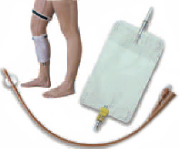Living with an Indwelling Urinary Catheter
Many thousands of people live active lives managing their bladder problem with an indwelling urinary catheter. There are a number of medical conditions that may lead to bladder problems, which may result in the need for catheterisation.

What is a Urinary Catheter?
A urinary catheter is a hollow flexible tube, which is inserted into the bladder by your nurse or GP (this is a simple procedure that you or your carer may learn at some stage). The catheter is kept in place by a special balloon that is inflated inside the bladder after insertion. This may be a long- or short-term measure depending on your medical condition.
Your catheter may be urethral (inserted into the bladder) or suprapubic (the catheter is inserted through the abdominal wall just above the pubic bone). Your catheter may take some time to adjust to, so do not worry, support is always at hand and you can contact your healthcare professional with any concerns that you may have.
Catheter Comfort
Following catheterisation, a urine drainage bag (leg bag) is usually connected to the end of the catheter.

The sterile bag can be worn on either the calf or thigh and may be held securely in place by velcro straps, or a cotton sleeve according to personal preference. Leg bags are available in different volumes i.e. 350ml, 600ml, 800ml up to 1300ml with varying inlet tube lengths. It is important to ensure that there is a clear drainage path from the catheter to the leg bag.
The Catheter Drainage System
As the catheter is in effect a foreign body it is vital to make every effort to avoid infection, therefore the leg bag should remain connected to the catheter continuously until it is due to be changed (usually every 5-7 days).
When the leg bag is full it must be emptied via the tap at the bottom end. Taps also vary and it is important to be aware of what is available, as some are easier to operate if finger dexterity is impaired (e.g. if you have arthritis).
Catheter Night Bags
Two-litre drainage bags are available for overnight use. These should be securely connected to the end of the leg bag and the leg bag tap opened to allow drainage. Overnight catheter bags are available with or without a tap.
Catheter Valves
Catheter valves are an alternative to leg bags. They are a simple tap that fits on the end of the catheter. By preventing urine from escaping from the catheter when the tap is closed they help the bladder work as it was intended. They are relatively small and discreet compared to using a leg bag.
Catheter valves should only be used on the advice of a qualified healthcare professional where adequate bladder tone and capacity are present and following full bladder assessment.
Catheter Hygiene
Hand hygiene is essential when you are dealing with your catheter. Your catheter and entry site should be washed twice daily with mild soap and water and dried thoroughly. If the entry site becomes inflamed check for chafing or other potential physical trauma, contact your continence specialist for advice if required.
Underclothes should be changed daily. AVOID THE USE OF CREAMS AND TALCUM POWDER. These may lead to “clogging” and potential infection. When bathing or showering, your leg bag should be emptied beforehand and left in place. Many people use two sets of straps, one for the shower and one to use when dressed.
Diet
Continue to eat a normal, healthy and balanced diet. Try to eat foods with a high fibre content (fruit, vegetables and whole grains) to avoid constipation.
Constipation can lead to pressure on the bladder and the catheter resulting in leakage and/or bypassing.
Do not consume cranberry in any form if you are on Warfarin as it can alter your blood results.

How much water should you drink with a catheter?
It is very important to drink plenty of fluids when you have a urinary catheter in place. Try to drink at least 1 to 2 litres daily.
What drinks should I avoid with a catheter?
Avoid excess caffeine and alcohol and drink clear fluids where possible.
Urine should be a light straw colour, if it is darker, increase your fluid intake. However, be aware that some medications can discolour urine; if in doubt, ask your GP or nurse. It is suggested that drinking cranberry juice on a daily basis will help prevent bladder infections; cranberry juice extract tablets are also available if you are not keen on the taste.
Sex with a Catheter
Sexual activity should be discussed prior to catheterisation. Although it is possible to maintain an active life with either a urethral or suprapubic catheter in place, the suprapubic may be preferable. You or your partner may wish to learn how to change the catheter so it can be removed before sex and replaced after. This also has the added advantage that should the catheter ever get blocked it can be replaced without having to call out a nurse.
Can you ejaculate with a catheter?
Yes. Ejaculation can be achieved while you have catheter without any detrimental effect.
Travelling with a Catheter
Using medical appliances for your continence needs should not affect your ability to lead a normal life and that includes travel. Below are some useful tips for you to consider when travelling.
Planning ahead
Prepare a checklist of products and items you need to take with you. These will include the products you normally use as well as anti-bacterial gel or wipes and disposal bags. You can keep these items in a small travel kit, so that you have your appliances and accessories to hand.
Travelling by plane
Before travelling, you will need to check with your airline their policy for carrying these items in your luggage, as Customs and Security officials may ask you questions about the appliances.
- Keep liquids in smaller bottles (less than 100ml capacity)
- Carry some supplies in your hand luggage
- Obtain a note from your GP stating that you need to carry some essential products in your hand luggage
Travelling by car or rail
If you use a drainable bag, you may find it helpful when making a long journey to carry a night bag in the vehicle. This will be helpful if you get stuck in a traffic jam and cannot get to a toilet.
Travelling by sea
Travelling by sea means you should not have as many problems as other forms of travel. Make sure you know where the toilets are located so that you can get to them quickly if you need to. They may be on a different deck in some instances.
If you are travelling on a cruise ship, make sure you know where the medical room is and how to contact the onboard GP in case of medical emergencies.
To read more travel advice tips, please call our customer services team on 0800 378 846 and they will send a copy to you.
Catheter problem solving
Bypassing – urine leaks out around the catheter instead of down the tube
- Check that there are no kinks in the tubing
- Make sure clothing is not too tight
- Avoid constipation
Catheter Discomfort
You may need a different size catheter or one made from a different material with a different coating; you can discuss this with your nurse. Check your catheter is well supported with a catheter retaining strap.
Cather Pain
This is unlikely but may be slight immediately after catheterisation. If you have persistent pain, contact your healthcare professional.
What does dark, offensive urine mean?
This may well be a sign of an infection. Try to increase your fluid intake and if you start to feel unwell and the colour and odour of your urine does not improve, consult your GP or nurse. Be aware that some forms of medication may affect the colour of your urine. Do not be alarmed but do mention any concerns you may have to your healthcare professional.
Blockage
If your catheter does not drain urine for 2-3 hours and you are experiencing abdominal discomfort, check that there are no kinks in the catheter, bag or tubing and that the bag is below the level of the bladder. If all is correct and the problem persists call your healthcare professional.
If you have any worries or are experiencing problems, always contact your healthcare professional, they are there to help you.
